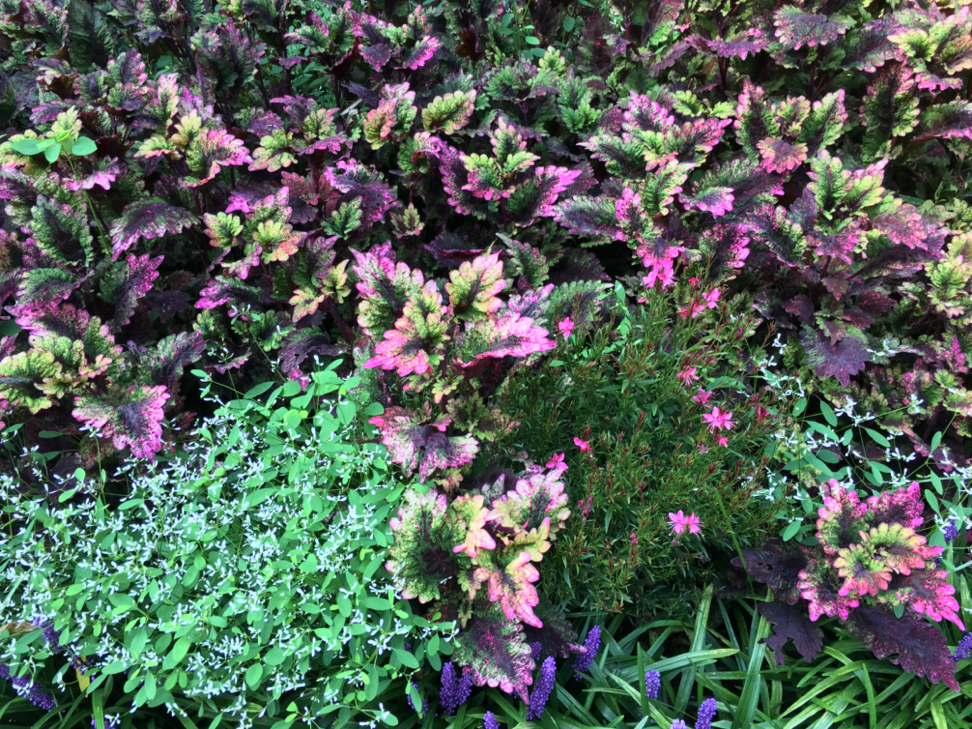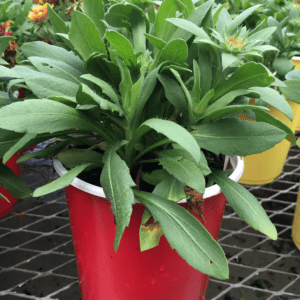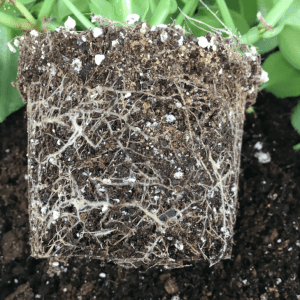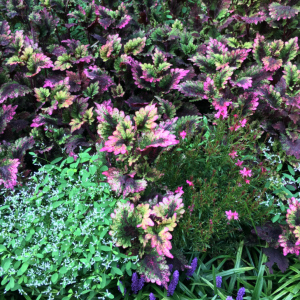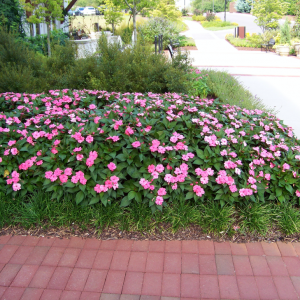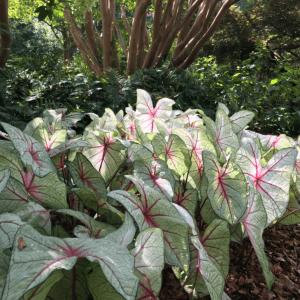Landscaping

Discover the different types of bedding plants, how to choose healthy plants and when and where to plant them.
The term bedding plant is not a botanical classification, but a term that describes a method of commercial production and marketing. Bedding plants are produced in a greenhouse and marketed in garden centers and mass-market businesses as a method of adding temporary seasonal color to the landscape. They are adapted to a wide variety of growing conditions and are generally easy to grow.
Many bedding plants are annual plants that complete their life cycles in a single growing season. Others are actually tender perennials that we treat as annuals in temperate regions of the country. Still others are bulbs, herbs, ground covers, vegetables, small fruits or woody plants. Consider these steps when installing an annual bedding plant display.
Determining Bedding Plant Season
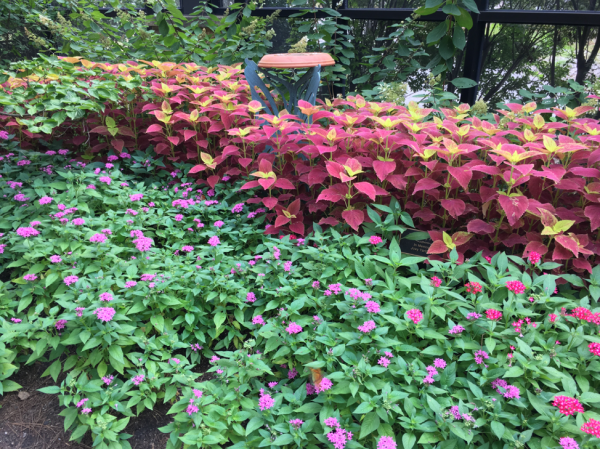
Figure 1. Coleus and Pentas make for a good combination in a full sun site
Traditionally, bedding plants have been planted in the spring for spring and summer color, with a second planting in the fall for winter color. However, it is possible to plant in all four seasons and have color year round with the long growing season and mild winters in Alabama.
The first planting of the year can be made in early spring as early as late February or March using semi-hardy annuals. Semi-hardy annuals can tolerate some frost and will grow and flower in the spring and early summer but will not withstand the summer heat. These include sweet peas, English daisies, hybrid petunias, snapdragons, English wallflowers, nasturtium, and sweet alyssum.
The second planting using tender annuals can be made in the spring when the chance of frost has passed. Tender annuals cannot tolerate frost but will withstand the summer heat. The list of tender annuals is extensive, ranging from impatiens to begonias.
The third planting using semi-hardy annuals a second time in the year can be made in the fall when temperatures begin to moderate in September or early October. These plants include chrysanthemums, snapdragons, ornamental cabbage, and kale.
The fourth planting using hardy annuals can be made in early winter from mid-October to November. Hardy annuals take considerable frost and freezing, and include pansies, Johnny-jump-ups, China Pinks, ornamental cabbage/kale, and hardy cultivars of snapdragons (Liberty or Sonnet series).
Table 1. Planting Dates for Annuals in Alabama
| Region | Semi-Hardy Spring Annuals | Tender/Summer Annuals | Semi-Hardy Fall Annuals | Hardy Winter Annuals |
|---|---|---|---|---|
| North Alabama | March 1 | May 1 | September 1 | October 1 |
| Central Alabama | February 20 | April 15 | September 15 | October 15 |
| South Alabama | February 10 | April 1 | September 25 | October 30 |
Choosing Healthy Bedding Plants
The ideal bedding plant is one that blooms quickly after planting, is free of insects and disease, and is heat and drought tolerant. The plant continues to bloom for a long time, has attractive flowers and foliage that suits your design purpose, and is a plant you like. In recent years, plant breeders have developed improved versions of existing bedding plants and introduced new plants to the market. They have developed plants that grow more compactly, produce more flowers, tolerate heat and drought better, tolerate more sun or shade, and come in an amazing range of flower colors.
When purchasing bedding plants from retail outlets, be aware that the quality of the plant can vary from one shipment to another at each store. Purchase stocky, compact plants with short, thick stems, many side branches, and a healthy green foliage color. Avoid stretched or spindly plants with yellow lower leaves. Do not insist on buying plants with open flowers. Green plants with few open flowers will grow more rapidly, filling in the area allotted in the garden. Examine shoots for insects or diseases, especially on the undersides of leaves. Avoid plants with yellow spots, burned leaf margins, or excessive lower leaf loss. Most importantly, examine the root system of the plants. A plant with a poor root system will not perform well in the landscape. Roots should fill out the container completely so the soil and plant come out as one unit. The roots should be white in color, especially at the tips. Avoid plants with black or brown roots.
-
Figure 2. Buy plants with healthy green foliage with many
flower buds, but few open flowers.
- Figure 3. Buy plants that have healthy white-tipped root systems that stay together when pulled from the pot
Healthy Plant Checklist
- Healthy, bright white roots that fill out the pot
- Stocky, strong stems
- Many buds, but few open flowers
- Good branching off the main stem
- No yellowing or spotted leaves
- No signs of insect damage
Deciding Where to Plant Annual Bedding Plants
Bedding plants have many uses in the landscape. They can be planted in flowerbeds (plantings that can be walked around and viewed from all sides) or flower borders (plantings with a backdrop, such as a fence, building, or woody plants on one or two sides) to provide temporary seasonal color. They can provide a bright source of color to draw the eye to a focal point in the landscape. Plant them in containers to accent decks, patios, or entrances to the home. Bedding plants can also be used in theme gardens, such as cut flower gardens, butterfly, or hummingbird gardens.
In landscaping, bedding plants are synonymous with dramatic garden color. They are the landscaper’s “paint-brush and color palate” because no other group of plants provides as wide a range of flower colors over as long a time as bedding plants do.
Bedding plants are often used as focal points to draw the eye of the viewer along an overall design or to highlight an object of interest in the landscape. Because they are strong visual items, it is easy to overuse them, especially in the formal area at the front of the home. Locating two or more focal points within a small area can be visually confusing. The best way to determine harmonious yet effective locations for bedding plants is to walk through the landscape and examine all viewpoints. Some natural positions for bedding plants are at the corner of outdoor rooms where borderlines converge, around hardscape items, or near the entryway to the home.
Many landscape problems can be addressed using bedding plants. They provide quick growth and early color to new landscapes while waiting for more permanent trees and shrubs to develop. Use bedding plants to fill voids in newly planted shrubbery. Colorful bedding plants can create interest in established landscapes. Use them to enhance outdoor family living areas, entertaining spaces, and entry ways.
Consider the cultural requirements of bedding plants when choosing a site in the landscape. Plants labeled as needing full sun will require at least six hours of direct sunlight. Plants described as shade loving need four hours or less of direct sun, preferably in the morning. These two groups generally cannot be mixed in the same planting. Most bedding plants require well-drained soil. If the soil is heavy clay or stays constantly wet, correct the problem before planting by incorporating a generous amount of organic matter into the soil to create raised planting beds.
- Figure 4. A variety of textures and colors can make for an interesting annual bed.
- Figure 5. Bright pink New Guinea impatiens draw the eye to the entryway of a building.
- Figure 6. Caladiums can add a bright spot of color to shady areas.
Creating Successful Color Combinations
Give some thought to flower color combinations when planning a bed layout. The primary colors on a color wheel are red, yellow, and blue; all other colors on the color wheel are derived from mixing primary colors. Placing primary flower colors next to each other in a design produces a strong contrast that may not be pleasing. Make transitions using shades and tints of primary colors.
Several color combinations have been developed that are pleasing to the eye.
- A monochromatic scheme uses one color combined with shades and tints of that same color. Supplement this scheme with white flowers or plants with silver or gray foliage. White, gray, or silver matches almost any color scheme.
- An analogous color scheme uses any two colors adjacent to each other on the color wheel, such as yellow and yellow-green or yellow and yellow-orange.
- Complementary colors are any two colors across from each other on the color wheel, such as yellow and blue or red and green. It often works well to make one of the two complementary colors dominant and use the other as an accent.
The lighting in the landscape can affect colors, too. White and light blue or yellow-colored flowers brighten shaded areas while dark-colored flowers tend to disappear. On the other hand, pastel-colored flowers tend to appear faded in full sun.
Establishing an Annual Planting Bed
The short life cycle and heavy flowering potential of annual plants require their growing medium to be nutrient-rich and well-drained. Garden beds should be carefully prepared before planting to ensure success. Begin by removing existing vegetation and working the soil with a tiller to the depth of 8-10 inches. Work 4 inches of organic matter (such as compost or soil conditioner) into the soil, as well as any fertilizers and lime recommended by a soil test. Contact your County Extension Office for more information on obtaining a soil test. Smooth the soil and slope the edges of the bed to improve drainage.
Layer annual plants in the bed to create a multi-layered design, with taller plants in the back and cascading plants on the bed’s front edge. Carefully read plant tags as to the distance between plants. If annuals are planted too closely, it will create leggy, weak stems in danger of falling over.
Take care not to plant too deeply; the plants should sit level with field soil. Add two inches of mulch over the entire bed, trying to avoid mulching plant stems, and then water the planting deeply. After watering, dig into the soil to make certain water has reached at least 6 inches down into the soil column.
The first 3-4 weeks after planting are the most crucial to success. During this time, plants are establishing root systems in the soil of the planting bed. Check for adequate moisture 2-3 times a week and water deeply as needed.
Summer maintenance will include weekly watering; beds will need approximately 1 inch of water per week, if not supplied by rainfall. Add fertilizer as needed in the form of a complete granular formulation, such as 8-8-8 or 10-10-10, at a rate of 2 pounds per 100 square feet, or based on soil test recommendations. Be sure to carefully rinse plants after applying a granular fertilizer to prevent foliar damage. Alternately, a slow-release fertilizer can be used, which is less likely to burn plants than a granular fertilizer and will give excellent growth for much of the growing season. Slow-release fertilizers such as 12-6-6 or 14-14-14, should be added at the rate suggested on the product label.
Some annuals (such as pansies, zinnia, and salvias) need deadheading to continue vigorous flowering throughout the summer. After each flower begins to fade, remove the flower stem at the first leaf below the flower. Other plants (such as coleus and begonia) have a tendency to grow tall and spindly rather than compact. Cut these back severely mid-season to assure strong stems later in the year.
Steps to Preparing Annual Beds
- Remove groundcovers such as sod from the area
- Till to a depth of 8-10 inches
- Till in 4 inches of organic matter and any fertilizers recommended in your soil test report
- Slope beds away from buildings and taper the edges to improve drainage
- Plant bedding annuals at the recommended distance
- Add 2 inches mulch over the entire bed
- Water 1 inch per week
Table 2. Characteristics of Selected Annual Bedding Plants
| Plant | Where to Plant* | Cold Tolerance** | Color*** | Time of Bloom**** | Height (inches) | Spacing (inches) | Comments |
|---|---|---|---|---|---|---|---|
| Ageratum (Ageratum houstonianum) | S-P | T | B, W, P | Sp-F | 8–18 | 10–12 | Good edging plant. Flowers rot in high heat and humidity. Plant again in fall. |
| Alyssum (Lobularia maritima) | S-P | T | W, P | Sp-F | 6–9 | 9 | Good for edging; fragrant. Flowers decline in midsummer. |
| Bachelor Button (Centaurea cyannus) | S | T | B, P, W, R | Sp-Su | 12–24 | 12 | One of the few blue flowers. A good cut flower, fresh or dried. |
| Begonia, Wax (Begonia x semperflorens-cultorum) | S-P | T | W, O, R | Sp-F | 6–12 | 12 | Many varieties available. Perpetual bloomer. Needs consistent soil moisture. |
| Black Eyed Susan Vine (Thunbergia alata) | S | T | O, Y | Su | 60–72 | 8–10 | Good climbing or hanging plant. |
| Black-eyed Susan (Rudbeckia hirta) | S | T | Y, O | Su-F | 12–24 | 12–18 | Heat and drought tolerant. Avoid over-head irrigation. Deadhead flowers. |
| Caladium (Caladium bicolor) | P-Sh | T | R, W, G | Su | 18.00 | 18 | Good source of color for shady areas, need warm soil for bulb to grow. |
| Calendula (Calendula officinalis) | S-P | H | O, Y | F-Sp | 9–18 | 12 | May survive winter and bloom in March in South Alabama. Late fall or early spring plant. |
| Calliopsis (Coreopsis tinctoria) | S | T | Y, O, R | Su-F | 24–36 | 12 | Heat and drought tolerant. Native wildflower. |
| Celosia, Cockscomb (Celosia argentea cristata) | S | T | R, O, Y, M | Sp-Su | 8–36 | 8–24 | “Brain-shaped” flower heads. Flowers rot with rain and high humidity. Some cut flowers. |
| Celosia, Plumed (Celosia argentea plumosa) | S | T | R, O, Y, M | Su | 12–48 | 10–18 | Good for dried arrangements; often reseeds; easy to grow. |
| China Aster (Collistephus chinensis) | P | T | V | F | 12–36 | 12 | Excellent cut flower. Spray for insects and diseases. Aster yellows virus a problem. |
| China Pinks (Dianthus chinensis) | S-P | H | R, P, M | F-Sp | 10–18 | 10–12 | Excellent for cutting; fragrant. Flowers fall and spring, green in winter. |
| Coleus (Coleus blumeli) | S-Sh | T | M, G, R | Su | 24–30 | 18–24 | Colorful foliage; easy to grow. Heat tolerant. Seed types for shade. Cutting types for sun. |
| Cosmos, Sulphur (Cosmos sulphureus) | S | T | Y, O, R | Su | 12–36 | 18–24 | Butterfly and bee attractant. Deadhead flowers. |
| Cosmos, Tall (Cosmos bipinnatus) | S | T | V | Su | 36–48 | 18–24 | Deadhead flowers. Good cut flower. |
| Dahlia (Dahlia spp.) | S-P | T | M | Su | 18–24 | 18–20 | Excellent cut flower. Spray for spider mites. |
| Dusty Miller (Senecio cineraria) | S-P | T | V | Sp-F | 8–24 | 12 | Easy to grow. Colorful. Foliage covered with dustlike down. |
| Fan Flower (Scaevola aemula) | S | T | B, P, W | Su | 4-9 | 18 | Spreading, ground cover annual. Heat and drought tolerant. Well-drained soil. |
| Flowering Maple (Abutilon x hybridum) | S-P | T | Y, O, R, W | Su | 12–36 | 24 | Rich soil, consistent soil moisture. Pinch to stimulate bushiness. |
| Flowering Tobacco (Nicotiana x sanderae) | P | T | V | Su | 12–24 | 12 | Sucking insects (aphids) a problem. Flowers close when temperature > 85°F. |
| Geranium (Pelargonium x hortorum) | S-P | T | W, R, P | Su | 18–24 | 24 | New varieties are easy to grow. Some need deadheading. |
| Globe Amaranth (Gomphrena globosa) | S | T | P, R, W | Su | 24–36 | 18–24 | Heat and drought tolerant. Holds color well as a dried flower. |
| Hollyhock (Alcea rosea) | S | H | R, W, V | Su | 36–72 | 12 | Some varieties are perennial; excellent background plant. |
| Impatiens (Impatiens walleriana) | P-Sh | T | V | Su | 12–24 | 12–24 | Blooms in deep shade better than other annuals; water often. |
| Impatiens, Balsam (Impatiens balsamina) | P | T | V | Sp-Su | 12–24 | 12 | Good for patios, rock gardens. Camellia-like flowers. |
| Impatiens, New Guinea (Impatiens hawkeri) | P | T | V | Su | 12–36 | 24 | Larger plant and flowers than impatiens; water often. |
| Johnny Jump Up (Viola tricolor) | S-P | H | V | F-W-Sp | 6–9 | 9 | Better winter annual than most pansies. Many exciting new flower colors. |
| Joseph’s Coat (Amaranthus tricolor) | S | T | R, Y, G | Su | 10–15 | 6–8 | Easy to grow; striking border; grows in dry locations. |
| Lantana (Lantana camera) | S | T | V | Su | 12–48 | 18–36 | Not recommended for South Alabama because it may become invasive. |
| Larkspur (Consolida ambigua) | S | H | V | F-Sp | 24–36 | 18 | Direct sow seed in the garden in the fall. Powdery mildew and fusarium problem in the heat. |
| Lobelia (Lobelia erinus) | P-Sh | T | B, P, W | Sp-F | 8–10 | 10 | Grows best during cool temperatures; edging plant. Cut back in midsummer forbetter fall flowering. |
| Love-in-a-mist (Nigella damascena) | S | T | B, W, P | Su | 12–24 | 18 | Interesting flower structure. Used as cut flower. Direct sow in garden. |
| Love-lies-bleeding (Amaranthus caudatus) | S-P | T | R | Su | 24–60 | 24 | Pendulous tassel flowers. Rich soil. Consistant soil moisture. Good dried flower. |
| Marigold, African (Tagetes erecta) | S | T | Y, O | Su | 12–36 | 18 | Easy to grow. Requires deadheading. |
| Marigold, French (Tagetes patula) | S | T | Y, O, R | Su | 8–15 | 10 | Easy to grow; many varieties. |
| Melampodium (Melampodium paludosum) | S | T | Y | Sp-F | 16–24 | 18 | Heat and drought tolerant. Tolerates poor soil. Can flop over in midsummer. |
| Mexican Heather (Cuphea hyssopifolia) | S | T | P, W | Su | 12–24 | 18 | Heat and drought tolerant. Attractive over a long period. |
| Mexican Sunflower (Tithonia rotundifolia) | S | T | O | Su | 36–96 | 36–48 | Large annual. Dwarf cultivars available. Butterfly attractant. |
| Million Bells (Calibrachoa x hybrida) | S | T | V | Su | 3–6 | 12–18 | Low, spreading ground cover. Heat and drought tolerant. |
| Monkey Flower (Mimulus x hybridus) | P | T | V | Su | 12–24 | 18 | Needs consistent soil moisture. Prefers warm days and cool nights. |
| Moss Rose (Portulaca grandiflora) | S | T | M | Su | 6–8 | 12 | Good ground cover. Well-drained soil. Heat and drought tolerant. |
| Nasturtium (Tropaeolum spp.) | S | T | M | Sp-F | 12.00 | 10–12 | Climbing or trailing cultivars available; fragrant. |
| Ornamental Cabbage & Kale (Brassica oleracea) | S | H | G, P, W | F-W-Sp | 10–12 | 12–18 | Cool-season plant producing showy foliage from fall to late spring. |
| Ornamental Pepper (Capsicum annuum) | S | T | O, R, Y | Su | 10–12 | 12 | Heat and drought tolerant. Fruit not eatable. |
| Pansy (Viola x wittrockiana) | S-P | H | V | F-W-Sp | 10–12 | 8–10 | Blooms through winter in South Alabama. Excellent with spring bulbs or for fall planting. |
| Pentas (Pentas lanceolata) | S-P | T | V | Su | 12–24 | 18 | Heat and drought tolerant. Good butterfly attractant. |
| Persian Shield (Strobilanthes dyerianus) | S | T | G, P | Sp-Su | 36–60 | 36 | Grown for purple- and silver-streaked foliage. Pinch early and often to keep bushy. |
| Petunia (Petunia x hybrida) | S | T | V | Sp-Su | 10–18 | 12 | The most popular annual; fragrant; easy to grow but not heat tolerant. |
| Polka Dot Plant (Hypoestes phyllostachya) | S-P | T | P, R, W | Su | 24–36 | 18 | Grown for colorful spotted leaves. Flowers usually removed. |
| Red Salvia (Salvia coccinea) | P | T | R | Su | 12–36 | 18 | Inflorescence more open than scarlet sage. Better weather tolerance than scarlet sage. |
| Sage, Mealycup (Salvia farinacea) | S-P | T | B, P, W | Su | 18–24 | 12–18 | Heat and drought tolerant. May be perennial in Deep South. |
| Sage, Scarlet (Salvia splendens) | S-P | T | R, P, W | Su | 12–24 | 10–12 | Excellent background plants; easy to grow. |
| Snapdragon (Anthirrhinum majus) | S-P | H | V | Sp | 8–36 | 12 | Good cut flower; fragrant. Can plant in fall or early spring. |
| Spider Flower (Cleome hassleriana) | S | T | W, P, R | Su | 36–60 | 24 | Can direct sow seed. May reseed vigorously. |
| Strawflower (Helichrysum bracteatum) | S | T | V | Su | 12–36 | 18 | Flowers strawlike to the touch. Needs well-drained soil. Root rot in wet soil. |
| Summer Snapdragon (Angelonia angustifolia) | S | T | W, P, B, M | Su | 24–48 | 12–18 | Heat and drought tolerant. Needs well-drained soil. |
| Sunflower (Helianthus annuus) | S | T | Y, O, R | Su | 36–84 | 18–24 | Bright flowers; good background or screen; unsightly late in summer. |
| Sweet Pea (Lathyrus odoratus) | S | H | V | Sp | 36–60 | 18 | Good background plant; fragrant. Plant seed in fall or early spring. |
| Treasure Flower (Gazania rigens) | S | T | V | Su | 9–18 | 18 | Heat and drought tolerant. Well-drained soil. |
| Verbena (Verbena x hybrida) | S | H | V | Su | 8–18 | 18 | Vining habit. Heat and drought tolerant. |
| Vinca (Catharanthus roseus) | S | T | R, W, P | Sp-F | 6–12 | 10 | Very heat and drought tolerant. Plant after soil warms. Avoid overhead irrigation. |
| Wishbone Flower (Torenia fournieri) | P | T | V | Su | 6–12 | 10 | Needs consistent soil moisture and protection from afternoon sun. |
| Zinnia (Zinnia elegans) | S | T | V | Su | 12–36 | 12 | Good cut flower; check varieties; easy to grow. Watch for powdery mildew. |
| Zinnia, Creeping (Zinnia angustifolia) | S | T | Y, O, W | Su | 10–15 | 12 | Good border or hanging plant; heat and drought tolerant. |
Allyson Shabel, Urban Regional Extension Agent, Alabama A&M University. Original prepared by J. Raymond Kessler, Jr., Ph.D., Horticulture Professor, Auburn University
Reviewed October 2021, Annual Bedding Plants, ANR-0184

